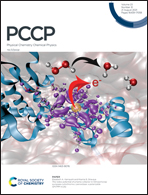Mapping the role of aromatic amino acids within a blue-light sensing LOV domain†
Abstract
Photosensing LOV (Light, Oxygen, Voltage) domains detect and respond to UVA/Blue (BL) light by forming a covalent adduct between the flavin chromophore and a nearby cysteine, via the decay of the flavin triplet excited state. LOV domains where the reactive cysteine has been mutated are valuable fluorescent tools for microscopy and as genetically encoded photosensitisers for reactive oxygen species. Besides being convenient tools for applications, LOV domains without the reactive cysteine (naturally occurring or engineered) can still be functionally photoactivated via formation of a neutral flavin radical. Tryptophans and tyrosines are held as the main partners as potential electron donors to the flavin excited states. In this work, we explore the relevance of aromatic amino acids in determining the photophysical features of the LOV protein Mr4511 from Methylobacterium radiotolerans by introducing point mutations into the C71S variant that does not form the covalent adduct. By using an array of spectroscopic techniques we measured the fluorescence quantum yields and lifetimes, the triplet yields and lifetimes, and the efficiency of singlet oxygen (SO) formation for eleven Mr4511 variants. Insertion of Trp residues at distances between 0.6 and 1.5 nm from the flavin chromophore results in strong quenching of the flavin excited triplet state and, at the shorter distances even of the singlet excited state. The mutation F130W (ca. 0.6 nm) completely quenches the singlet excited state, preventing triplet formation: in this case, even if the cysteine is present, the photo-adduct is not formed. Tyrosines are also quenchers for the flavin excited states, although not as efficient as Trp residues, as demonstrated with their substitution with the inert phenylalanine. For one of these variants, C71S/Y116F, we found that the quantum yield of formation for singlet oxygen is 0.44 in aqueous aerobic solution, vs 0.17 for C71S. Based on our study with Mr4511 and on literature data for other LOV domains we suggest that Trp and Tyr residues too close to the flavin chromophore (at distances less than 0.9 nm) reduce the yield of photoproduct formation and that introduction of inert Phe residues in key positions can help in developing efficient, LOV-based photosensitisers.



 Please wait while we load your content...
Please wait while we load your content...